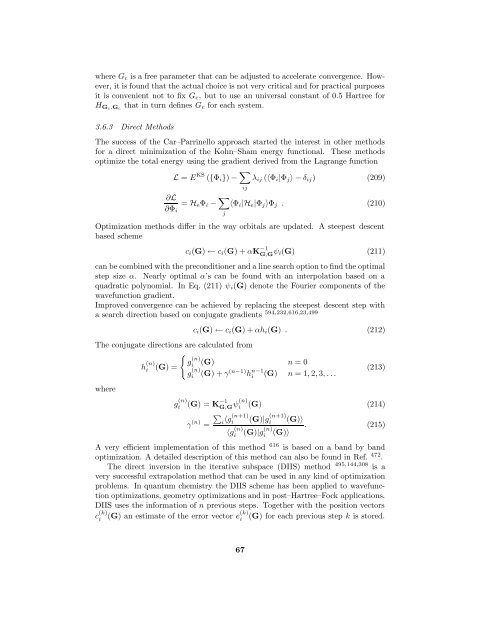Ab initio molecular dynamics: Theory and Implementation
Ab initio molecular dynamics: Theory and Implementation
Ab initio molecular dynamics: Theory and Implementation
- No tags were found...
You also want an ePaper? Increase the reach of your titles
YUMPU automatically turns print PDFs into web optimized ePapers that Google loves.
where G c is a free parameter that can be adjusted to accelerate convergence. However,it is found that the actual choice is not very critical <strong>and</strong> for practical purposesit is convenient not to fix G c , but to use an universal constant of 0.5 Hartree forH Gc,G cthat in turn defines G c for each system.3.6.3 Direct MethodsThe success of the Car–Parrinello approach started the interest in other methodsfor a direct minimization of the Kohn–Sham energy functional. These methodsoptimize the total energy using the gradient derived from the Lagrange functionL = E KS ({Φ i }) − ∑ ijλ ij (〈Φ i |Φ j 〉 − δ ij ) (209)∂L∂Φ i= H e Φ i − ∑ j〈Φ i |H e |Φ j 〉Φ j . (210)Optimization methods differ in the way orbitals are updated. A steepest descentbased schemec i (G) ← c i (G) + αK −1G,G ψ i(G) (211)can be combined with the preconditioner <strong>and</strong> a line search option to find the optimalstep size α. Nearly optimal α’s can be found with an interpolation based on aquadratic polynomial. In Eq. (211) ψ i (G) denote the Fourier components of thewavefunction gradient.Improved convergence can be achieved by replacing the steepest descent step witha search direction based on conjugate gradients 594,232,616,23,499The conjugate directions are calculated from{g (n)whereh (n)i (G) =g (n)ic i (G) ← c i (G) + αh i (G) . (212)i(G) n = 0(G) + γ (n−1) hi n−1 (G) n = 1, 2, 3, . ..g (n)i(G) = K −1γ (n) =(213)i (G) (214)G,G ψ(n)∑i 〈g(n+1) i (G)|g (n+1)i〈g (n)i(G)|g (n)i(G)〉. (215)(G)〉A very efficient implementation of this method 616 is based on a b<strong>and</strong> by b<strong>and</strong>optimization. A detailed description of this method can also be found in Ref. 472 .The direct inversion in the iterative subspace (DIIS) method 495,144,308 is avery successful extrapolation method that can be used in any kind of optimizationproblems. In quantum chemistry the DIIS scheme has been applied to wavefunctionoptimizations, geometry optimizations <strong>and</strong> in post–Hartree–Fock applications.DIIS uses the information of n previous steps. Together with the position vectorsc (k)i(G) an estimate of the error vector e (k) (G) for each previous step k is stored.i67









